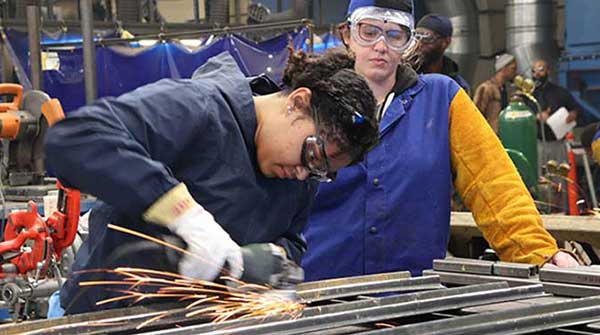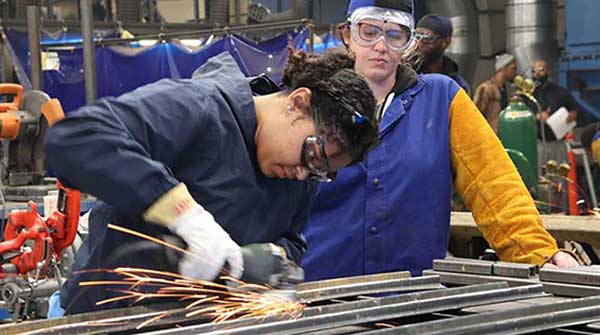How the great Canadian skilled trades shortage impacts various industries

For interview requests, click here
The fridge has stopped working, and your frozen food is melting. You call your usual appliance repair service only to find its cadre of four technicians has dwindled to two overloaded workers. They’ll do their best to come as soon as possible but can’t give a specific date. You contact friends about stuffing some food in their freezer and then try to use up the rest before it goes bad.
Welcome to the great Canadian skilled trades shortage!
The problem goes far beyond your local appliance technician. It’s nationwide, impacting every industry. A shortage of airplane mechanics is making it increasingly difficult to keep planes in the air. A construction boom in housing and commercial buildings has created unprecedented demand for construction trades. And the need to replace aging transportation infrastructure is occurring simultaneously with population growth requiring new highways and bridges. A Canadian Manufacturers and Exporters survey found that 42 per cent of their member companies had lost contracts or paid late delivery penalties because they lack skilled workers.
 |
| Related Stories |
| If we want to thrive, we need bright young workers
|
| Women still facing barriers to careers in skilled trades
|
| Set aside the stereotypes and put young people to work |
How did this skilled trade shortage happen? A big part of the answer is demographics: Many of the baby boomers who built or maintained virtually all the things we take for granted in our modern way of life retired during the COVID shutdowns.
And there are more retirements to come. A report released last January by Employment and Social Development Canada projects that 700,000 skilled trades workers are expected to retire by 2028.
So why aren’t they being replaced?
Part of the answer is a stigma common among parents and secondary school teachers who consider university attendance more “respectable” than Trades College. The result of this condescending attitude is that many students who would be better suited to skilled trades enter lower academic requirement liberal arts programs that are of little use to themselves or society.
As a result, arts enrollment is mushrooming. The University of British Columbia’s 2020 undergraduate report includes the troubling statistic that its arts faculty enrollment was twice the combined enrollment in engineering, pre-medicine and all other sciences, skills that are also in critically short supply.
Skilled trades training provides the opportunity for fulfilling careers, both professionally and financially. Moreover, many tradespersons build their own successful businesses. So how can we close the skilled trades gap?
The demographic trend of retirements exceeding new apprentices was already evident in 2011 when I became volunteer chair of B.C.’s Industry Training Authority (ITA), the organization responsible for funding and facilitating trades training in the province. While our first goal was to bring new apprenticeships into balance with retirements, we knew that the province’s rapidly growing economy would require many more tradespeople than that. To offset the pro-university attitudes of parents and schoolteachers, we needed to connect students with the trades well before they left high school. So we began “Trades Discovery” programs that introduced students to apprentices and practicing tradespersons, with participation counting toward high school credits. Other provinces have since introduced similar high school programs, including Ontario’s trades “boot camps.”
The good news is there’s a relatively untapped demographic with huge potential to narrow the trades gap: women. Historically, chauvinistic attitudes have discouraged women from entering trades careers. But the new generation of tradesmen is much more supportive of women tradespersons.
Still, women often have challenges that most men don’t have. Many are single working moms. Government programs cover tuition fees, but childcare and living support can be insurmountable barriers. One woman who lived beyond commuting distance from an apprenticeship program had to find funding for accommodation and support.
Victoria’s Camosun College has an exemplary program supported by private funding called Empowering Women in Trades. Over the past five years, it has helped 220 students achieve their trades qualification dreams. Among these students have been Indigenous women and female new immigrants, both largely untapped sources of tradespeople.
Next time one of your appliances fails, a smiling woman may arrive lugging her tool kit. More power to her!
Gwyn Morgan is a retired Canadian Business Leader who lives in Victoria.
Troy Media
Troy Media is committed to empowering Canadian communities by providing independent, insightful analysis and commentary. Our mission is to support local media in building an informed and engaged public by delivering reliable content that strengthens community connections, enriches national conversations, and helps Canadians learn from and understand each other better.

